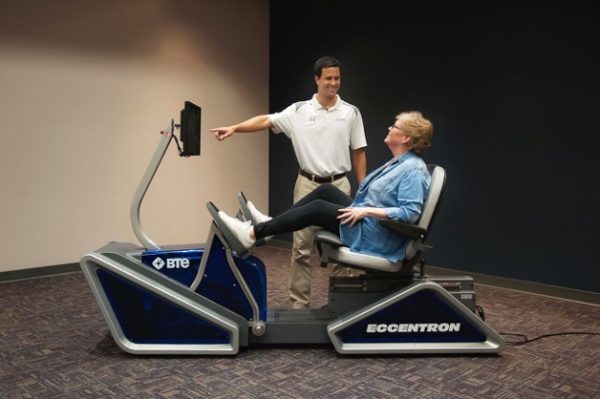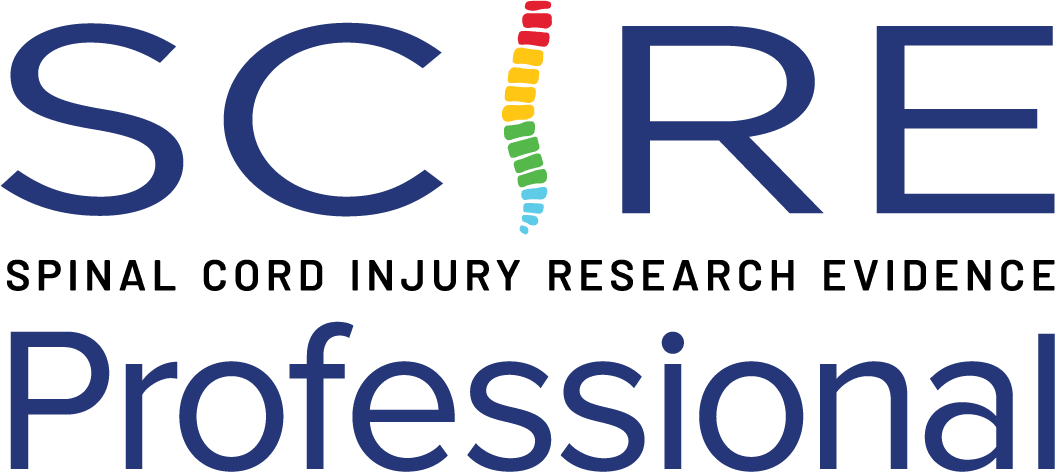Eccentric Resistance Exercise Using the Eccentron
Active lower body eccentric resistance training (RT) may improve ambulatory capacity after incomplete SCI; however, the attenuated muscular force capacity following more severe incomplete SCI may be insufficient to stimulate muscular adaptations necessary for RT or ambulation (Stone et al. 2019). As seen in previous sections, those with incomplete SCI often perform RT alone (Labruyère & van Hedel 2014), through NMES (Stone et al. 2019), or paired with gait training (Gorgey & Sheherd 2010) to improve ambulatory capacity. Eccentric RT may be an optimal training regimen for those with incomplete SCI seeking increased muscular strength without external NMES or therapist-assisted training (Stone et al. 2019). Few studies assessed the effects on walking capacity and lower limb strength after a training intervention based on eccentric exercise using the Eccentron in participants with SCI (Stone et al. 2018; Stone et al. 2019).
The Eccentron (BTETech, Hanover, MD, USA; see figure 11) is a motor driven eccentric recumbent stepper (Stone et al. 2019). Originally designed to train older adults, athletes, or those who have had cardiopulmonary complications, the Eccentron delivers a controlled and measurable negative muscular overload (Stone et al. 2019). Training on the Eccentron allows a person with incomplete SCI to bilaterally work the limbs and visually track the accuracy of force production during repetitions (Stone et al. 2019). The Eccentron may assist in concurrently improving lower extremity muscle strength and reciprocal limb activation, both of which may improve ambulatory function (Stone et al. 2019).

Figure 11. The Eccentron. From www.btetechnologies.com
Discussion
The pre-post studies of Stone et al. (2019) and Stone et al. (2018) used an eccentric recumbent stepper (i.e., Eccentron, which targets the gluteal, hamstring, and quadriceps muscles) for resistance training twice a week, with an intensity of 50% 1RM and a dosage of 2-3 sets of 8 repetitions at 12 rpm (Stone et al. 2019; Stone et al. 2018). Compared to baseline, at 6 weeks and at 12 weeks of training, participants significantly improved their walking speed (10MWT) and walking ability (WISCI II) (Stone et al. 2019). It should be noted that the improvement in 10MWT performance across the intervention was positively correlated with the change identified in daily step physical activity (Stone et al. 2019). Lastly, lower limb eccentric and isometric strength also improved; however, daily step physical activity remained unchanged (Stone et al. 2018).
Conclusions
There is level 4 evidence (from 2 pre-post studies: Stone et al. 2018; Stone et al. 2019) that an eccentric RT program for the lower limbs, using the device Eccentron, performed twice a week for 12 weeks with an intensity of 50% 1RM improves walking speed, walking ability, and isometric and eccentric strength, but not daily step physical activity on participants with chronic SCI.
